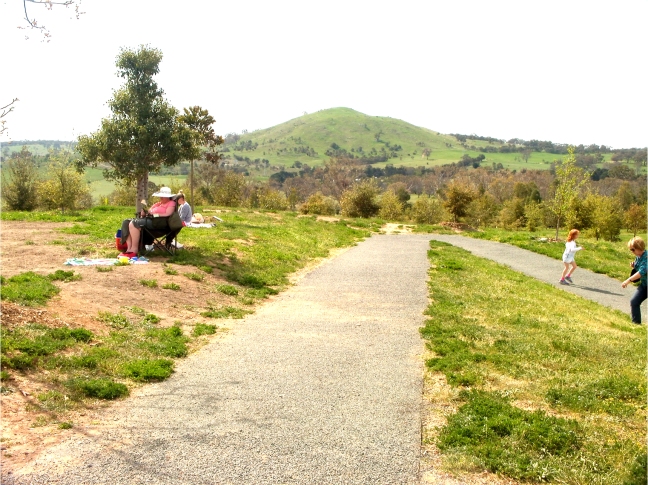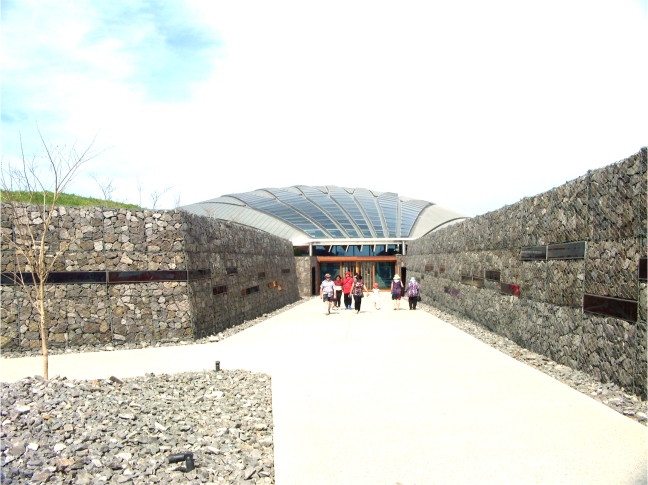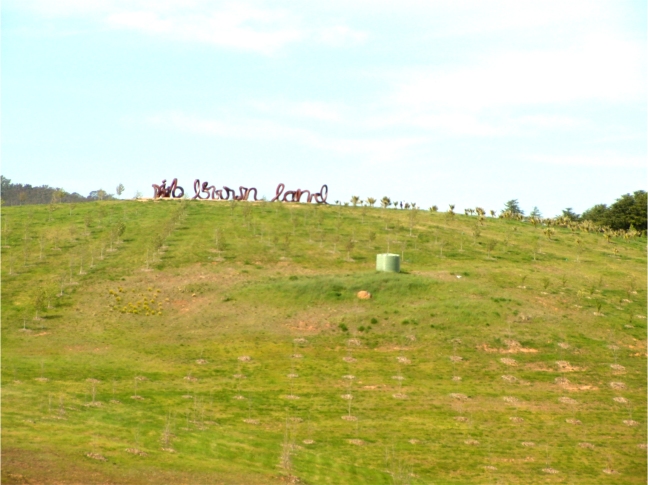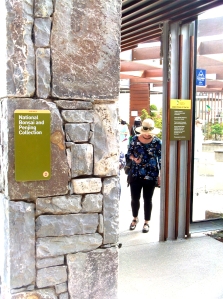One of the themes of my visual sociology is the representation of science. Conservation is as much about social practices as it is about earth science, biology and other natural sciences. Today’s post is about the sociology of the National Arboretum, which sits on Ngunawal country. Ngunawal people are the traditional custodians of this part of Acton, west of the city in Canberra. Less than a seven minute drive central business district, this is one of the world’s largest arboretums for rare and endangered trees. I am no arborist. I cannot even claim to be a fan of gardening. I was interested in the Arboretum first in an attempt to capture a visual sociology of Canberra, and second to see how people interact with this place as a science centre. The focus of my post today is on the social dynamics of the Arboretum, especially on community aspects of conservation and the trees that drew the greatest interest amongst the crowds I saw: the Bonsai and Penjing Collection .

Canberra’s roots
 The Ngunawal people have been in Acton for at least 25,000 years. The National Arboretum was built relatively recently, near an area sacred to the Ngunawal people. The land is diverse in plant-life as well as being rich in traditional Aboriginal knowledge of sustainable practices.
The Ngunawal people have been in Acton for at least 25,000 years. The National Arboretum was built relatively recently, near an area sacred to the Ngunawal people. The land is diverse in plant-life as well as being rich in traditional Aboriginal knowledge of sustainable practices.
The Arboretum is home to 44,000 trees from over 100 countries, organised into 94 forests. Three of the forests are over a century old, with the first of these planted in 1917.
While the American architect who designed Canberra, Walter Burley Griffin, had initially intended to establish an arboretum, the National Arboretum was formally built 90 years later, after the 2003 bushfires that devastated the area.
On the day I visited, the Arboretum was well attended by families and groups of friends who were charmed by the beautiful setting.
The Village Centre beckons with its science fiction-themed dome exterior. It was opened in 2013, and now displays information about the forests as well as community planning and sustainability.

Community science
The Village Centre has a focus on community science, visually displaying the data collection efforts of volunteer groups such as the Friends of the National Arboretum, the Canberra Ornithologists Group and FrogWatch. These “citizen scientists” collect tree and other biological measurements. For example, frog observation is central to better understanding the ecology of the surrounding area.
The Arboretum is used as a site to study climate change. In collaboration with the Australian National University, three forests are being used to simulate drought conditions to see how trees cope with environmental stress. Some species such as the spotted gum relies on a complex root system to sustain its water intake and others such as the red ironbark stops growing during times of drought.
Another community science element highlighted at the Arboretum is the Avenues of Honour around Australia, which dedicate the planting of trees in remembrance of fallen soldiers. The Arboretum tells us that the country town of Ballarat in outer western Melbourne was the first to establish this tradition. Similarly the nearby town of Bacchus Marsh, a 20 minute drive from where I grew up, planted close to 300 trees in 1918, four years after the first group of local soldiers went to war.
There is bountiful sociological value at the Arboretum. Displays about community and identity demonstrate how local and national practices are linked to trees and sustainability. A sign tells us:
Trees are part of national identity. They witness our triumphs and our tragedies.
Australiana is evoked via the corten steel sculpture that screams ‘Wide Brown Land‘ atop a hill. Australians would recognise this famous line from Dorothea Mackellar’s quaint and beloved poem ‘My Country.’ The artwork, made in 2010, uses cursive handwriting in an ode to Mackellar, and it can be read clearly from afar, evoking nostalgia and patriotism.

Despite the splendour of the artwork, such a grand-scale celebration of Australia’s Anglo-Celtic roots stand in stark contrast to the Arboretum’s engagement with Aboriginal and Torres Strait Islander cultures. While the Arboretum has an Indigenous program of guided activities, this educational resource seems to be a pre-booked service.
It might be curious that there is not more Indigenous science and art on display beyond the entrance, nor did there seem to be Indigenous professionals on site. Unfortunately, this is one way in which the Arboretum is sorely lacking, as is the case with other science programs. Indigenous knowledge has much to teach us about science, including ecology and sustainability. This is one consistent pattern I see when I visit public sites dedicated to science: the absence of Indigenous contribution and leadership.
From China to Japan to Oz
 The National Bonsai and Penjing Collection is a delight, with around 80 varieties of overseas and local miniature trees designed to inspire cross-cultural connections between Australia, China and Japan.
The National Bonsai and Penjing Collection is a delight, with around 80 varieties of overseas and local miniature trees designed to inspire cross-cultural connections between Australia, China and Japan.
Aged 60 years or less, the Bonsai trees in the Arboretum are only one tenth the age of their counterparts in their native homeland. From black Japanese pines to mini moss gardens, there is much to absorb.
While many Westerners outside of Japan may have heard of bonsai, penjing is the Chinese tradition of miniature landscaping and actually predate the art of bonsai. Penjing also feature rocks, figures and multiple species in the one setting. Take the Reed Pipe Rock (left below, click to enlarge). It is made from soft stones; perfect for sculpting a space for the trees which are later added. Look closely at the Chinese elm (right below). Can you see the little red fruit in the trees, above the coy red deer that watches the frolicking birds?
The Dwarf Alberta Spruce (below) are a bonsai variety. The white parts of the trunk are painted to represent dead wood; ‘jin‘ is the name for the branches and ‘shari‘ is the trunk.

A standout was the Queensland Small-Leaf Fig, styled from a native tree planted in 1987.

One of my favourite pieces is the 165 million year old petrified tree stump fossil (below) donated by the National Dinosaur Museum. It dates back to the Jurassic era, preserved in sediment that replaced the plant material with silica, opal and other organic materials.

The Bonsai and Penjing Collection easily drew the largest crowds. People talked in low, animated tones pointing out beautiful foliage, while others spoke more loudly, especially Anglo-Australian men, showing off their botanical knowledge.




Family flight
Families with young children tended to rush through the outside garden that is dense with fascinating information about local conservation techniques, such as how to plant the most resilient native species in sustainable local gardens. Instead, many opted to play on the impressive Pod Playground. I must admit I wanted very badly to climb up that slide but norms of adulthood kept me firmly in place!
Others flew colourful kites in the luscious outdoors amphitheatre. A glorious array of gliding paper was on show. One family flew a giant Rainbow Flag (a symbol of lesbian, gay, bisexual, transgender, queer, and intersex people). A Chinese-speaking family commandeered a giant dragon. Others opted for modest handmade affairs, while there were also a couple of impressive motorised kites. In fact, there were more adults gleefully flying kites than their children, who ran around squealing and rolling down the hill in sublime joy.
Whatever one chooses to indulge at the Arboretum – whether it’s bonsai admiration, climbing pods, or a sociological frolic through information displays – a very good day is guaranteed for one and all.



















Thanks for sending me this wonderful subjects regards John
On Sat, Jul 9, 2016 at 10:40 AM, The Other Sociologist wrote:
> Dr Zuleyka Zevallos posted: “One of the themes of my visual sociology is > the representation of science. Conservation is as much about social > practices as it is about earth, biology and other biophysical sciences. > Today’s post is about the sociology of the National Arboretum, which si” >
LikeLike
You’re welcome, John. Thanks for stopping by.
LikeLike